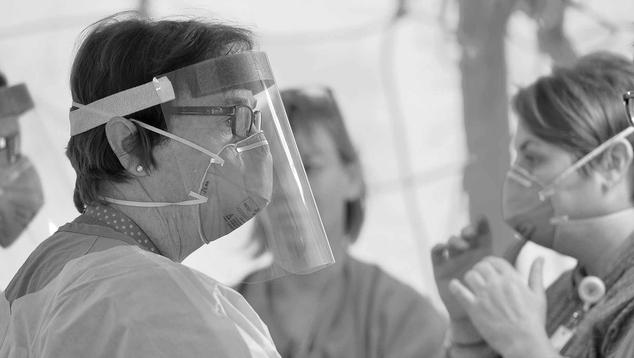WASHINGTON, D.C. -- Gallup has covered a lot of ground this past week in our daily measurement of Americans' experience of the COVID-19 crisis. Here is what we know as of April 2.
Emotions, Home Schooling and Return to Normalcy
New data reported on news.Gallup.com this week provide insights into the range of emotions Americans are experiencing. These are baseline measures that will be critical indicators of Americans' mindsets as the crisis intensifies, and as it eventually subsides.
U.S. Emotions Mixed After a Tense Month of COVID-19 Response (March 31)
We also took an initial read on parents' views of their children's education, as 96% of parents tell us their child's school has closed. How are Americans' youth being taught, and how do parents feel about it?
42% of Parents Worry COVID-19 Will Affect Child's Education (March 31)
Americans' reliance on social distancing isn't likely to wind down as quickly as it ramped up according to this first Gallup look at Americans' comfort with getting back to "normal."
Americans Hesitant to Return to Normal in Short Term (April 1)
Cracks in Physical Wellbeing, Personal Connections
While the news and social media offer anecdotal evidence that Americans are taking advantage of social distancing and time at home to improve their exercise and nutrition, Gallup's polling of Americans paints a less rosy picture. While most adults report no change in their wellness behaviors, more say their diet and exercise have worsened than improved.
Few Report Improved Diet, Exercise Amid COVID-19 Crisis (April 2)
Separately, we find that 54% of U.S. adults are not sensing any change in their connectedness to family and friends in the past week, but 28% say they are now less connected and 18% feel more connected.
Most in U.S Report No Change in Connectedness Amid COVID-19 (April 2)
Americans Taking Social Distancing Seriously
In our last briefing (March 31), we reported a further uptick in Americans' self-isolation, finding nearly as many U.S. adults are avoiding small gatherings of friends or family (83%) as are avoiding mass transportation or air travel (89%). Now that the nation is reaching maximum adherence to broad social distancing measures, these figures may level off.
Separately, we find that a third of U.S. adults are maintaining complete separation from people outside their household. Another 50% are mostly isolating themselves. As more Americans succumb to the virus and states potentially strengthen their stay-at-home orders for residents, the percentage practicing complete isolation could climb sharply higher.
| Completely isolated | Mostly isolated | Partially isolated | Isolated a little/No attempt to isolate | ||||||||||||||||||||||||||||||||||||||||||||||||||||||||||||||||||||||||||||||||||||||||||||||||
|---|---|---|---|---|---|---|---|---|---|---|---|---|---|---|---|---|---|---|---|---|---|---|---|---|---|---|---|---|---|---|---|---|---|---|---|---|---|---|---|---|---|---|---|---|---|---|---|---|---|---|---|---|---|---|---|---|---|---|---|---|---|---|---|---|---|---|---|---|---|---|---|---|---|---|---|---|---|---|---|---|---|---|---|---|---|---|---|---|---|---|---|---|---|---|---|---|---|---|---|
| % | % | % | % | ||||||||||||||||||||||||||||||||||||||||||||||||||||||||||||||||||||||||||||||||||||||||||||||||
| March 27-29 | 25 | 48 | 18 | 10 | |||||||||||||||||||||||||||||||||||||||||||||||||||||||||||||||||||||||||||||||||||||||||||||||
| March 23-26 | 25 | 44 | 19 | 11 | |||||||||||||||||||||||||||||||||||||||||||||||||||||||||||||||||||||||||||||||||||||||||||||||
| March 20-22 | 20 | 44 | 22 | 14 | |||||||||||||||||||||||||||||||||||||||||||||||||||||||||||||||||||||||||||||||||||||||||||||||
| March 16-19 | 16 | 36 | 21 | 28 | |||||||||||||||||||||||||||||||||||||||||||||||||||||||||||||||||||||||||||||||||||||||||||||||
| Response options: 1) Completely isolated yourself, having no contact with people outside your household; 2) Mostly isolated yourself, having very little contact with people outside your household; 3) Partially isolated yourself, having some contact with people outside your household; 4) Isolated yourself a little, still having a fair amount of contact with people outside your household; 5) Did not make any attempt to isolate yourself from people outside your household | |||||||||||||||||||||||||||||||||||||||||||||||||||||||||||||||||||||||||||||||||||||||||||||||||||
| Gallup Panel, 2020 | |||||||||||||||||||||||||||||||||||||||||||||||||||||||||||||||||||||||||||||||||||||||||||||||||||
Links to Earlier Stories
Review Gallup's findings from the past two weeks on support for the economic rescue package, insights on disruption to American workers, including how workers are coping with the transition to remote work and more.
Bipartisan Support for COVID-19 Rescue Legislation (March 30)
U.S. Employees Increasingly Seeing COVID-19 Effects at Work (March 27)
11 Million in U.S. at Severe Risk If Infected With COVID-19 (March 27)
Six Emerging Conclusions: Public Opinion and COVID-19 (March 27)
Americans Increasingly Expect Economic Recession (March 26)
Most U.S. Adults Expect Long-Term COVID-19 Disruption (March 25)
Coronavirus Response: Hospitals Rated Best, News Media Worst (March 24)
Americans Step Up Their Social Distancing Even Further (March 24)
Americans Rapidly Answering the Call to Isolate, Prepare (March 20)
Most U.S. Workers Not Yet Drastically Impacted by COVID-19 (March 19)
U.S. Economic Confidence Slides Amid Coronavirus Situation (March 18)
Half of U.S. Workers Expect COVID-19 to Harm Workplace (March 16)
U.S. Coronavirus Concerns Surge, Government Trust Slides (March 16)
The content for this blog was contributed to by Lydia Saad, Jeffrey M. Jones, Megan Brenan, Mohamed Younis, Jenny Marlar and Angelina Theodorou.
Find all Gallup articles about COVID-19 on the COVID-19 Topics page.
Explore Gallup's advice for employers on leading and managing workers at this critical time on Gallup's COVID-19: Leading Through Disruption landing page.




